 |
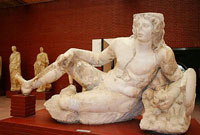 |
|
In the beginning, in 1929, artifacts from diggings and the surrounding were brought here and stored. In 1964, what is now the museum's southern section was built and artifacts were displayed there. The room was not big enough for the increasing number of artifacts so, in 1995 another section was added and used for exhibition. The Selcuk Ephesus Museum is the most important and richest museum for possession and sole display of local artifacts. |
|
| The Ephesus Museum is a rich and important museum for Ephesian and Anatolian archeology with artifacts from digs at Ephesus, St. John's Church, the Belevi Mausoleum, and other local ruins. Including artifacts from the Mycenian, Archaic, and Turkish periods as well, the majority are from the Hellenistic, Roman, Byzantine periods. |
|
| Terrace Houses Room: In the first room of the museum are finds, mainly from the Roman Period, that have come to light over the last fifty years from excavations in the "Hillside Houses". On the left are the plan of the houses and photos of the excavation. In the first showcase are medical and cosmetic artifacts. The second case displays home religious cultic items. The most interesting of these is a glass tray. |
|
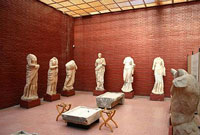 |
|
| In the niche opposite is a fresco from one of the houses with a statue of Artemis the huntress and a bust and fresco of Socrates. On the left side of the room are a bust of Emperor Marcus Aurelius and statuettes of the gods Priapos and Bes. Three of the museum's most important possessions are in the central room. These are an Eros with dolphin from the 2nd century, a statue of an Egyptian priest, and a copy of a Roman statue of Eros by Lysippus. |
|
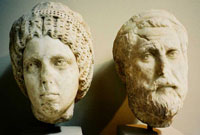 |
|
Fountain Artifacts: In this room are finds from the Pollio, Trajan, and Laecanus fountains at Ephesus. To the immediate left of the door is a bust of Zeus and a statue of Aphrodite. In the center of the room is statue of a "Resting Warrior". To the left is the statue group of "Odysseus-Polyphemos" which decorated the Pollio fountian. The first figure is Dionysius reclining on a tree trunk. |
|
| The other statues are a reclining satyr, an Aphrodite with oyster shell and Anrocles with dog. On the right of the room is a series of busts. These belonged to the statues at the Laecanus Bassus Fountain. |
|
| Recent Findings Room: Some recent finds have been on exhibit here for a year or two. In the display case to the immediate right of the door are Byzantine finds from the Christian era. On the left side of the room are coins and jewelry. Pre-Roman coins from Ephesus have the city symbol, a bee, on one side and the deer of Artemis on the other. Coins from the Roman period show the emperor, or his lieutenants, or some imperial symbol. |
|
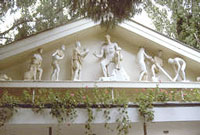 |
|
| On the left wall hang theater masks made of leather or wood and were found at the Grand Theater in Ephesus. Such masks made of stone were used for decoration. On the same wall is a lamp stand from Ephesus. Other important artifacts in the room include a masked Eros, amphoras, figure of Eros, a statue of Aphrodite, and various busts, including one of Menander, the playwright. The only thing that remains permanently in the room is an ivory frieze from the "hillside houses". The frieze shows Trajan fighting eastern barbarians and three sections from his preparation to fight. |
|
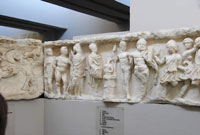 |
|
The Garden: The museum has a garden that fits in with the local architecture. On the right of the garden are sarcophagi, gravestones, sacrificial altars and inscriptions. The sarcophagus from the 2nd century is decorated with quite interesting ornamentation. The figures on it resemble figures of Moses. Judging by the inscription on its lid it was used again in the Byzantine period. |
|
| Along the west wall of the garden there are grave and offering stones on display. The sundial in the center is in a half-moon shape. |
|
| Grave Artifacts Room: This room opening from the garden displays finds from the gravesites. On the left wall are drawings of Anatolian burial customs. On the left are small artifacts taken from a Mycenian grave in front of St. John's Church dating from the 14th or 13th centuries BC, proving that the history of Ephesus dated from before Androcles.
|
|
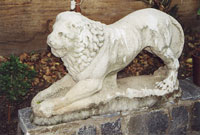 |
|
| In another display case are small glass artifacts taken from graves in and around Ephesus. At the end of the room are numerous stele taken from sarcophagi in the area. |
|
 |
|
Artemis Room: This is where statues of Artemis and things related to the goddess are on display. There are two statues on display showing their former glory. These were found by accident in the prythaneionda and dated from the 1st century AD. The statue on the left is known as "Great Artemis" and the other one is "Beautiful Artemis". In the display cases are artifacts from the temple to Artemis. There is a horse from one of the temple chariots on display too. |
|
| Imperial Cult and Portrait Salon: In this room there are generally imperial family busts. The most noteworthy feature is the crowns that were engraved into the foreheads of the busts. The statue to the right of the door leading from the Artemis Room was of the consul Stephanos. On the left, on either side of the picture of the Temple to Hadrian are original friezes from that temple. The altar in the center was a piece of the U-shaped altar of the temple to Domitian. There are friezes on three sides of it. Just before leaving the room there are pieces from the giant statue to Domitian. There are also pieces from statues of August and his wife, Livia in the room. |
|
|
 |
|
|
|